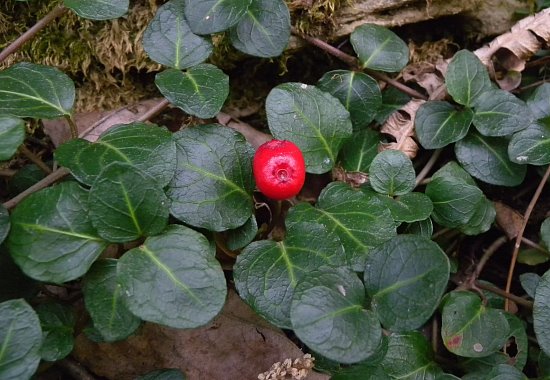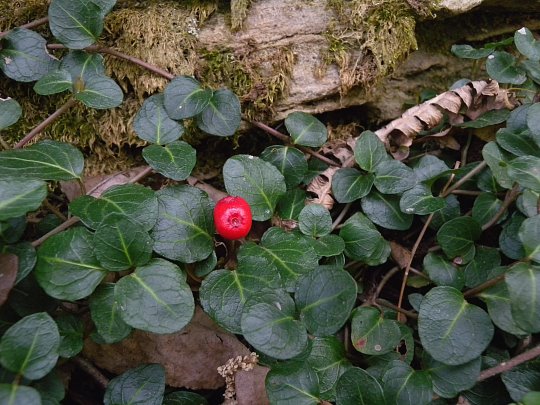
Pairs of upright flowers occur at the tips of branches or from the axils of leaves. Each flower has a hairy white corolla about ½" long, 4 stamens, and a pistil with single style. Each pair of flowers share the same short-tubular calyx. The corolla is trumpet-shaped with 4 spreading lobes, while the calyx is light green with tiny teeth along its upper rim. There are 4 filiform stigmata per style. There are two types of flowers: those with long stamens and short styles, and those with short stamens and long styles. However, only one type of flower can be found on any individual plant. The blooming period occurs from late spring to mid-summer. The flowers are fragrant. As a result of the fusion of their ovaries, each pair of fertile flowers is replaced by a single berry. The berries are bright red, subgloboid in
Cultivation: The preference is light shade to partial sun, moist to dry-mesic conditions, and an acidic soil containing sand or rocky material (e.g., sandstone). Partridge Berry is not aggressive and it can be difficult to establish. However, it can be cultivated in a partially shaded rock garden where the soil is shallow and competition from other plants is restricted. Flowers and fruits are sparingly produced.
Range & Habitat: The native Partridge Berry occurs occasionally in NE Illinois and southern Illinois, while in the rest of the state it is uncommon or absent. This small vine is distributed across a wide area of eastern North America. Habitats include rocky upland woodlands, sandy savannas, slopes of wooded sand dunes, sandstone cliffs, sandstone ledges along ravines, mossy boulders in wooded ravines, rocky river banks, edges of Red Maple swamps, and bogs. Partridge Berry is found in high quality natural areas.
Faunal Associations: The flowers are cross-pollinated by bumblebees (Hicks et al., 1985). The primary floral reward for these insects is nectar. Apparently very few insects feed on the foliage of Partridge Berry. Some upland gamebirds feed on the fruits of this vine, including such species as the Ruffed Grouse, Bobwhite Quail, Wild Turkey, and the now extinct Passenger Pigeon (Martin et al., 1951/1961; Bennetts, 1900; Schorger, 1955). Mammals that feed on the fruits include the Red Fox, Eastern Skunk, Eastern Chipmunk, White-Footed Mouse, and Woodland Deer Mouse (Martin et al., 1951/1961; Hamilton, 1941). These animals spread the seeds of the berries to new locations.

Photographic Location: A shaded sandstone ledge along a river at the The Potholes in west-central Indiana.
Comments: This is the only species of its genus in North America. Partridge Berry has ornamental foliage, flowers, and berries. It can distinguished from other woody vines by its small size, pairs of showy white flowers, and long-lasting red berries. Another common for this species is Twinberry.